| Moderated by: chrisbet, |
|
|
| Re-celling an EN-EL4 batteryWithout spilling too much blood... | Rate Topic |
| Author | Post |
|---|
| Posted by Robert: Tue Jan 2nd, 2018 02:45 | 1st Post |
| This continues a post in the 'Wanted' section. The cells from the original Nikon EN-EL4 battery are 18.4mm Dia. and 65mm long depending where you measure them. In general working terms I would call them 18650 cells. The cells which were in my D1 EN-4 battery pack which I fitted at least 8 years ago measure 17.8mm Dia. and are 65mm long. I checked the Voltage both packs I have and they were 7.8 Volts and 7.3 Volts respectively. Given it's at least a year since I charged them and they have sat unused in my cabinet they must still be in good condition. The EN-EL4 pack split quite easily but the cells were stuck in the top half of the housing with very sticky double sided tape and were quite tough to remove without damaging the connections or the small PCB. I plan to install the Samsung 18650 cells from my EN-4 pack into the EN-EL4 case. I am expecting it to be a tricky operation because the solder tags on the Samsung cells have been already clipped to fit the EN-4 housing but I have a large hammer and crowbar so I can make them whatever I wish! I have only nicked myself once with my Stanley knife so far, so it's going well!!! Sorry about the image, I thought the iPhone would have made a better attempt. Attachment: Nikon battery cells.jpg (Downloaded 41 times)
____________________ Robert. |
| Posted by jk: Tue Jan 2nd, 2018 04:08 | 2nd Post |
| The red cells are the original Nikon ones? What are I think this looks easy especially after my original exploits with the D1, D2X batteries. I think that the two options with tagged cells or free cells needs to be driven by how you want to charge the cells. The options are to treat the 18650 cells like an large AA battery where you treat the original EN-EL4 case as a holder. The other option is to use tagged cells and rebuild the battery with new cells.
____________________ Still learning after all these years! https://nikondslr.uk/gallery_view.php?user=2&folderid=none |
| Posted by Robert: Tue Jan 2nd, 2018 04:59 | 3rd Post |
| My opinion hasn't changed since I did the D1 EN-4 project. Soldered in and seal the unit. Charging is no longer an issue, charging the cells was the main reason for having to be able to pull the cells out, unless you did my trick of improvising a special 7.2 Volt two cell charger which plugged into the pack like the original charger did. Yes, the red cells are the original Nikon cells from the EN-EL4 pack. Agreed, it's a dead easy project in comparison with the D1 EL-4 project which involved cutting a large hole in the casing due to very tight clearances. I got these (green) Samsung cells from CPC Farnell's at Preston. They in two pack, shrink wrapped pairs which had overheat sensors between the cells. I stripped that to the bare cells and re-built using the original Nikon PCB. This is much easier because I can recharge using the normal MH-21 charger, I had to buy and improvise a special charger for the Samsung cells. That will still charge my UV lamp unit but I may cannibalise the UV lamp unit and revise the batteries for that. Cross that bridge when I come to it... Possibly a small 12 Volt lead acid battery would do for that. Which is another possibility for the large external power pack, to get ten volts, drill into a car battery where the cell link is between the fifth and sixth cells and tap off 11.5 volts for the camera. These EN-EL4 packs are showing over 12 Volts at the battery to camera contacts, therefore the camera must be able to tolerate at least 12 volts. The battery can still be charged normally but cell six won't get used. It's a trick often used with trucks, they are usually 24 Volt but CB radios are usually 12 Volt, so they just use half of the 24 Volt battery. Works perfectly well.
____________________ Robert. |
| Posted by jk: Tue Jan 2nd, 2018 08:10 | 4th Post |
| Yes there can be issues with seating and gettng good connections with the unsoldered cells.
____________________ Still learning after all these years! https://nikondslr.uk/gallery_view.php?user=2&folderid=none |
| Posted by Robert: Tue Jan 2nd, 2018 09:43 | 5th Post |
| There has to be a substantial electrical connection, it needs to pass, without resistance, at least 4 amps @ 10 Volts without delay, the shutter capacitors depend on it. That's why the D1 used to fail to fire the shutter unless it got all the juice it needed, immediately. I assembled my first D1 EN4 battery with smaller gauge wire and it didn't work, I replaced the smaller gauge wire with something larger and it worked perfectly. I would get over 1200 exposures from those batteries on the D1 and D1X. That was unheard of, A good, new battery was usually around 300 exposures per charge, from memory. I think any external battery will need to have a short lead to the camera, since at that voltage and with DC, the voltage drop will be a factor. In fact it may need all six cells of a 12 Volt lead acid battery to get a good response, and perhaps it might be a good idea to have cells in the camera, continuously replenished by the lead acid battery. Although, perhaps that may bring issues with 'over charging'... One of the links I posted contained the full technical specifications of the 18650 cell and it stated it could produce 30 Amps full load, not sure how long for...
____________________ Robert. |
| Posted by Robert: Tue Jan 2nd, 2018 10:42 | 6th Post |
| This is an interesting link... https://www.youtube.com/watch?v=Ceos88VO6p4 Very polished. However, there are many alternative and much cheaper options alongside that offering. I think that will be the way I will go, spot welding the tags on myself will be much better. I have single sided spot welded 316 stainless steel 1.2mm sheet, many times. It's an easy, quick process requiring very little gear. I realise this is a different scale but the principle is the same.
____________________ Robert. |
| Posted by Robert: Mon Jan 8th, 2018 15:08 | 7th Post |
| This evening as the Christmas hubbub fades away I got back to my task of re-celling the only dubious battery I have, a genuine Nikon EN-EL4 D3 battery which was on 'life 4' according to the camera battery meter. It was very quick to recharge which made me suspicious about it's capacity. I removed the PCB from the original cells by cutting the links close to the cells to give myself something to work with to re-solder them to the cells I salvaged from my D1 battery. I have partly re-connected the 'new' cells to the PCB but it's a somewhat floppy assembly and not wanting to get a short circuit or other silliness I have applied some "Gorilla Glue" to the areas where the cells touch. That should make it a more stable assembly so I can complete the second set of soldered connections on the other side of the battery. That should only take a few minutes in the morning. The most difficult bit was linking the two cells under the PCB, it might have been better to have linked them at the non PCB end, there isn't as much room, but it might have been easier, next time...
____________________ Robert. |
| Posted by jk: Mon Jan 8th, 2018 16:31 | 8th Post |
| Keep going Robert. Please post some photos. I am travelling to UK tomorrow. I will be stuck on Seaton, Devon until 21st when I return to Spain.
____________________ Still learning after all these years! https://nikondslr.uk/gallery_view.php?user=2&folderid=none |
| Posted by Robert: Tue Jan 9th, 2018 03:22 | 9th Post |
| Thanks JK, it was a battle royal last night. Re-using the D1 battery cells wasn't the brightest of ideas I have had recently. The tabs on the cells were trimmed when I first utilised them, now I am having to extend the tabs and tag bits of wire in to make connections. Not pretty or particularly easy considering the very limited space available. I ought to get some nickel plated strips but that's a pain so I am going to plod on and patch this for now. Not very satisfactory but will do a better job with the next one, if I can get another EN-EL4 to cannibalise together with new tagged cells. Will try to get some pix but this is really just one sticky mess! If I can tidy it up some then I will. The key to this is fresh cells with nice clean tags, have thought about a spot welder but unless I am going to make a lot of battery packs up it isn't worth it. There is no way I would do this to sell them on as cheap units. Way too risky if one caught fire. A crude unregulated welder isn't going to make reliable welds so that's a non starter. Even making my own, regulated welder would be quite expensive, well over a hundred quid. Then there would still be some risk of spoiling some cells setting it up. The difference between a good weld and a poor weld is not much with such thin metal.
____________________ Robert. |
| Posted by Robert: Tue Jan 9th, 2018 04:11 | 10th Post |
| Mmmm... A tag has just broken off a cell, wasn't welded on properly... (What chance do I stand!) Will order three new cells with tags, start again. The tags are 0.15mm thick by 5mm wide, which gives a cross sectional area of 0.75 square mm (Can't do superscript here I don't think?) The material is nickel plated steel, higher resistance than copper. 1 square mm copper wire should be well able to handle the current, yet be pliable and small enough to install. Can't solder directly to the cells because it will melt the plastic internals and possibly cause an explosion and fire.
____________________ Robert. |
| Posted by Robert: Tue Jan 9th, 2018 05:51 | 11th Post |
| Ordered three cells from RS components. https://uk.rs-online.com/web/p/speciality-size-rechargeable-batteries/8801551/ Not perhaps the cheapest but I am suspicious of the eBay stuff and these cheap on-line sellers seem too full of gimmicks for my liking. I need a reliable long term result, not a flash in the pan.
____________________ Robert. |
| Posted by jk: Wed Jan 10th, 2018 12:58 | 12th Post |
| Have you seen these? This is a three cell pack but also come in 2 and 4 cells enclosures. https://www.ebay.co.uk/itm/Battery-Holder-Box-Case-DIY-for-battery-packs-1x-2x-3x-4x-18650-cells-UK-FreeP-P/182891735071?hash=item2a9532681f:m:mooQhmh4rS23BLh2OK38M1Q Means you can use standard untagged cells and you can swap cells in/out for your battery charging or replacement needs. This makes for a good external battery. You would need to identify a way to lock the cells into the EN-EL4 for internal battery recelling. In this case it is probably best to use tagged cells.
____________________ Still learning after all these years! https://nikondslr.uk/gallery_view.php?user=2&folderid=none |
| Posted by Robert: Wed Jan 10th, 2018 16:56 | 13th Post |
| Thanks JK, will look into that.
____________________ Robert. |
| Posted by Robert: Thu Jan 11th, 2018 17:14 | 14th Post |
| Please can anybody suggest a source for small quantities of copper foil, about 0.15mm thick (or thin!) this equates to 0.005 of an inch (five thou) or 36 Imperial wire gauge. I don't need much, an A5 sheet would probably last me for years! I have searched and searched but it needs to be a UK supplier who is happy to supply small quantities. Possibly some specialised craft or model shop? It's for the tag connections, the tags provided on the ends of the cells aren't long enough nor in the right places radially at the battery ends. Soldering wire connections of sufficient capacity is bulky in the tight confines of the battery housing, there isn't room. The tags are nickel plated steel and are 0.15mm thick by 5mm wide. I don't want to go much thicker to retain flexibility for assembly. Copper will have less electrical resistance than nickel plated steel and be more ductile and flexible. It's also easier to work, can be cut with sharp scissors, craft knife, etc, and very easy to solder. I did consider brass but it's not so flexible and it cracks when repeatedly bent.
____________________ Robert. |
| Posted by jk: Fri Jan 12th, 2018 03:04 | 15th Post |
| Brass or copper will work. Craft store is the place to go or check in B&Q as I saw some there some time ago. They do brass rod (actually rectangular section which would work). Remember with copper and brass you can heat it and beat it to make it easier to work with.
____________________ Still learning after all these years! https://nikondslr.uk/gallery_view.php?user=2&folderid=none |
| Posted by Robert: Fri Jan 12th, 2018 14:30 | 16th Post |
| Scrounging round a scrap yard I found a piece of clean 0.5mm thick copper, will anneal it tomorrow and see what it's like but I think it's a bit thick. It's OK for some parts but not flexible enough for the battery to PCB connection which has to be like a hinge.
____________________ Robert. |
| Posted by jk: Wed Jan 31st, 2018 06:51 | 17th Post |
| How is the re-celling activity going? I have six new ordinary 18650 cells. I might have a go building a unit if I find any of my batteries die.
____________________ Still learning after all these years! https://nikondslr.uk/gallery_view.php?user=2&folderid=none |
| Posted by Robert: Wed Jan 31st, 2018 15:40 | 18th Post |
| Have stalled slightly, cars and life getting in the way a bit. I have glued the cells together with Gorilla glue so they are 'as one' I have found some thin copper, 7 thou I think. They are sat waiting for the soldering iron... I am also creating a panoramic head for 360/180º spherical panoramas. I have got my lathe up and running at last. This is an 'artists' impression of the pano head, turned from solid aluminium. 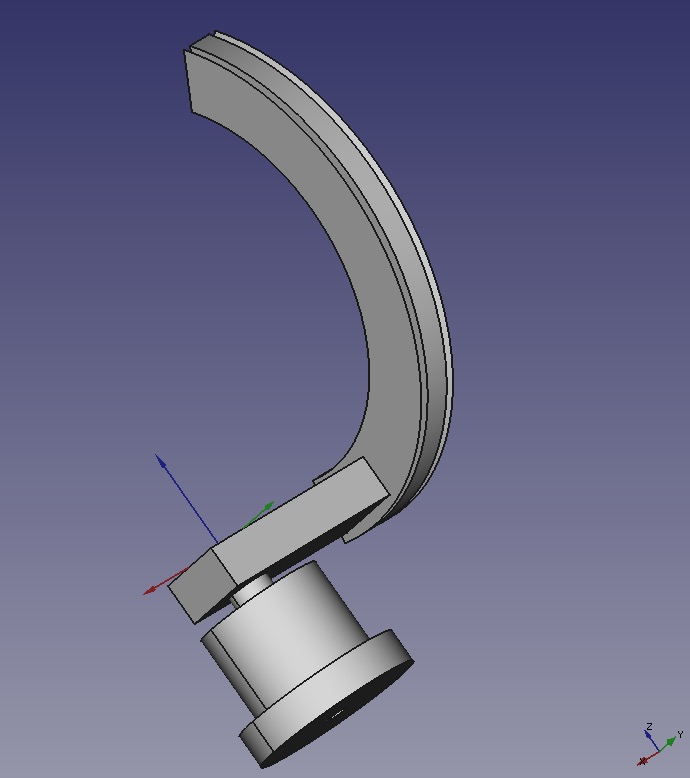 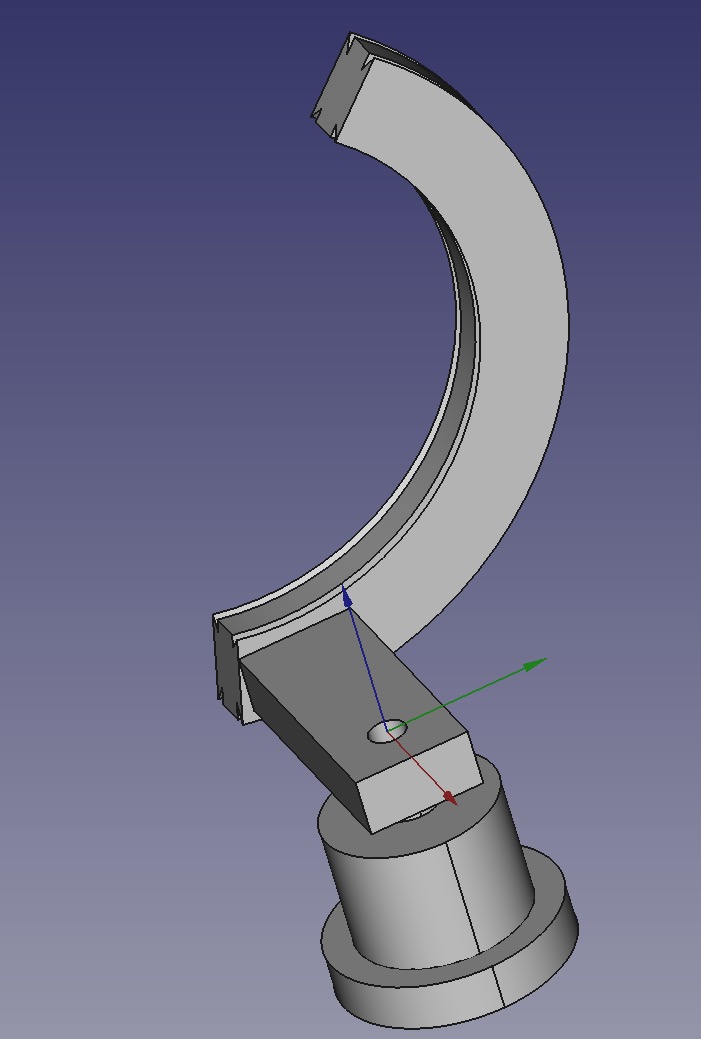 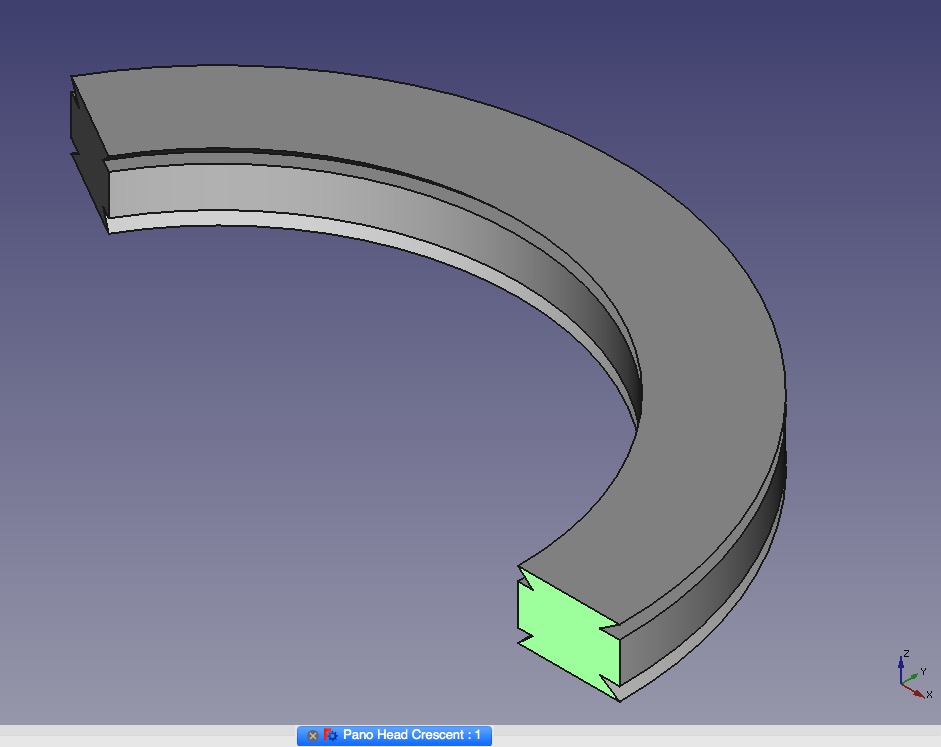 I have made the curved bit and am working on the revolving hub at the moment. Need to incorporate some sort of click locations to the vertical (pan) axis. Have made the main hub parts, tomorrow I make the steel shaft for it to rotate on.
____________________ Robert. |
| Posted by Robert: Wed Jan 31st, 2018 15:53 | 19th Post |
A couple of drawings, the intended lens being my 16mm f2.8 fisheye. The red marks denote the field of view of the lens at horizontal. 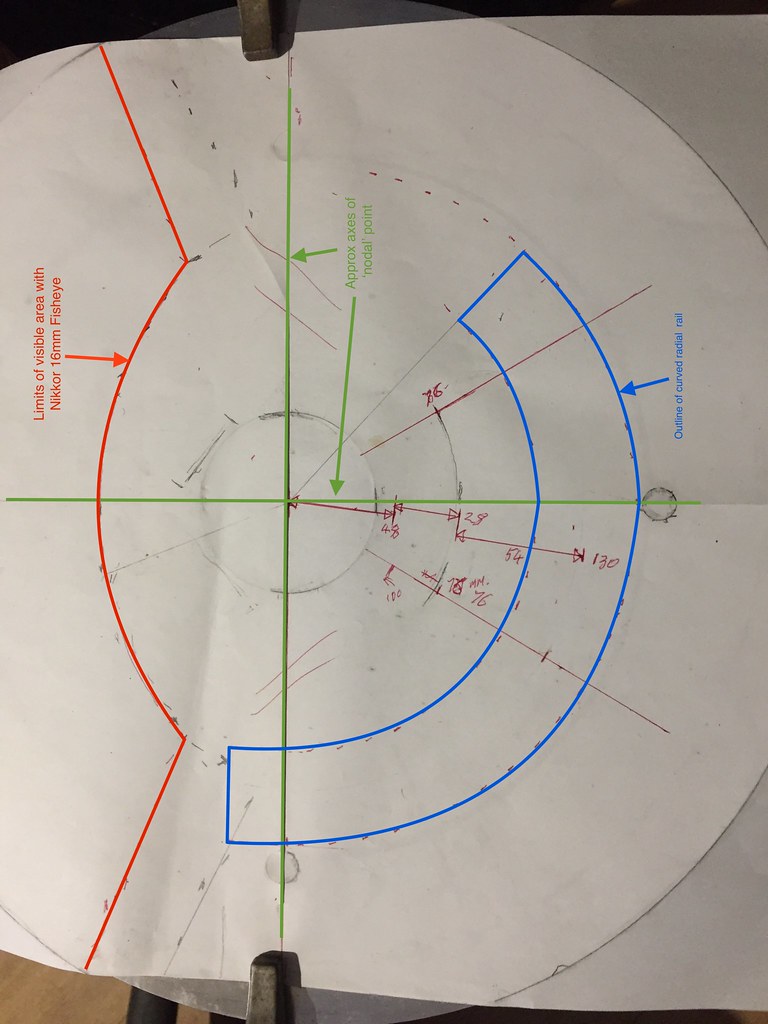 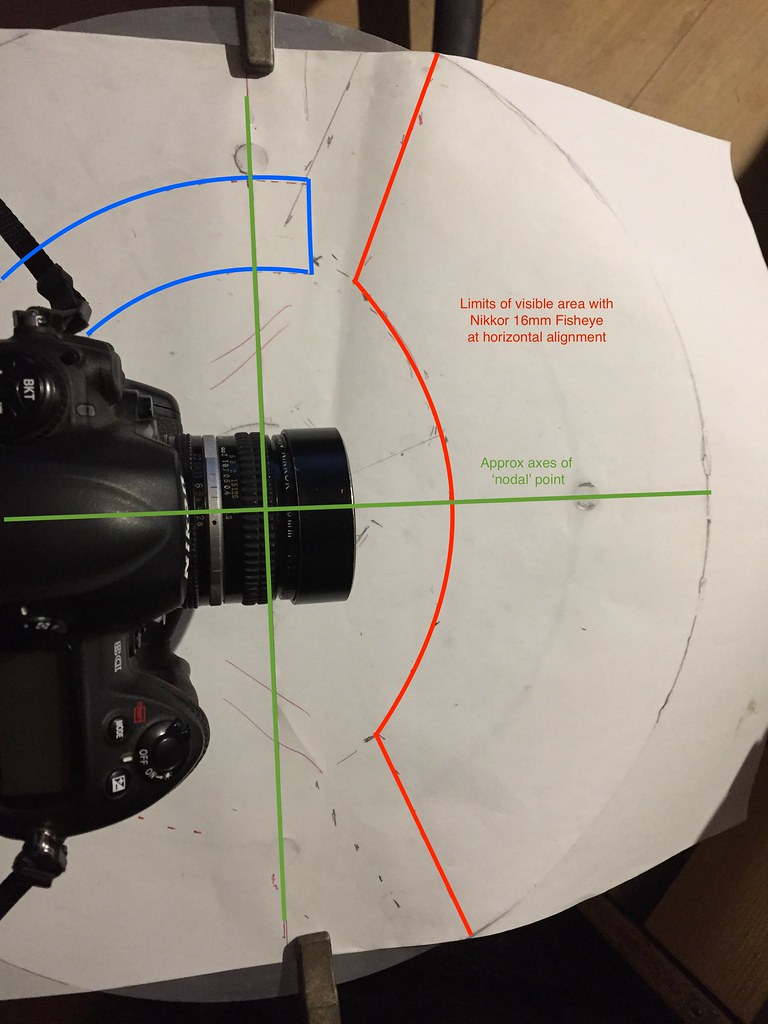 The centre axis of the partial ring is at the nodal axis, both vertical and horizontal, the pan axis is taken care of by the length of the arm connecting the hub and the curved dovetail ring. That will be fixed for each camera, two arms, one longer for the D3 the other shorter for the D200 and D300.
____________________ Robert. |
| Posted by jk: Wed Jan 31st, 2018 16:38 | 20th Post |
| What software you using for your CAD.
____________________ Still learning after all these years! https://nikondslr.uk/gallery_view.php?user=2&folderid=none |
| Posted by Robert: Wed Jan 31st, 2018 16:57 | 21st Post |
| FreeCAD. I was very sceptical at first, it took me a week to get into it but as you can see, while I haven't mastered it, I have produced a reasonable likeness. Once you realise how it works and stop trying to do what you (or I) knew from 2D drafting software, (which I have used for years) it's pretty easy. There are tutorials but I found a French, I think it was, You Tube video, despite not having a clue what he was saying, I followed it easily from that video, yet I had watched numerous video's with English commentary and I couldn't get the hang of it at all.
____________________ Robert. |
| Posted by Robert: Thu Feb 15th, 2018 09:09 | 22nd Post |
| OK, some progress after the Pano head project got in the way... I have almost completed re-celling one EN-EL4 battery. I still have to seal the case closed but it's in a charger as I type doing a re-calibration to see if that gets rid of the 'age 4' in the camera menu, battery condition report. Yes, I have had it in the D3, it works as expected, although it was very tight to get in and out, without the casing being glued together. Part of the reason this project stalled was because I was very concerned about the tight space for the connections. While I am reasonably dexterous I am really out of my comfort zone working on such small and critical things like the internals of an EN-EL4 battery. I hate disclaimers... but seriously, unless you actually possess the experience and skills of working with compact electronics, leave the EN-EL4 battery well alone. It isn't easy and remember, you will be working with FULLY CHARGED LIVE BATTERIES; they can occasionally explode and definitely can and do catch fire. I have taken some more photographs which I will process while I wait for the calibration. I had some difficulty in getting the case to close, there is zero spare space in the plastic housing. I had wrapped a small ring of red insulating tape around each cell to identify the live (positive) end, even that had to come off because it was preventing the casing from closing properly. Also I used 'Gorilla Glue' to join the cells together to make it easier to handle the cells, the Gorilla Glue foams slightly and therefore expands. I had to file all the excess glue away as well. If I do another of these, I will make a small jig to hold the batteries together when they are glued. I used one half of the casing and that ended up contaminated with foamed glue which is the devil to get off, especially while avoiding damaging the casing. Like I say, there is no room for anything except the cells.
____________________ Robert. |
| Posted by Robert: Thu Feb 15th, 2018 14:32 | 23rd Post |
| Here are some photos of the cells in the EN-EL4 battery. Firstly the original cells which I think were 1900mAh.     Followed by various views of the replacement Samsung cells, 2600mAh The foaming Gorilla Glue can be clearly seen. 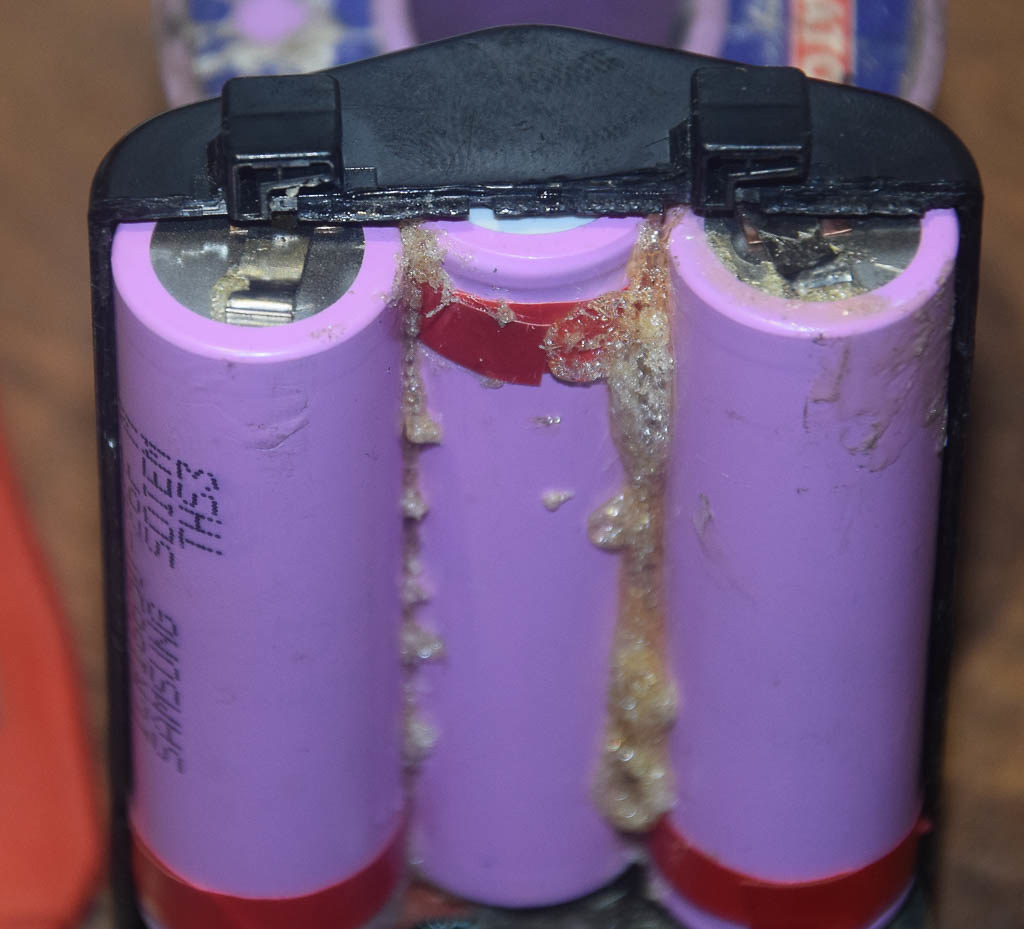 The trickiest and probably most critical joints are shown here, They connect the PCB to the two positive tags at the PCB end of the batteries. The clearance on these is critical as they protrude to the maximum possible and prevent the casings from closing properly if not perfect. 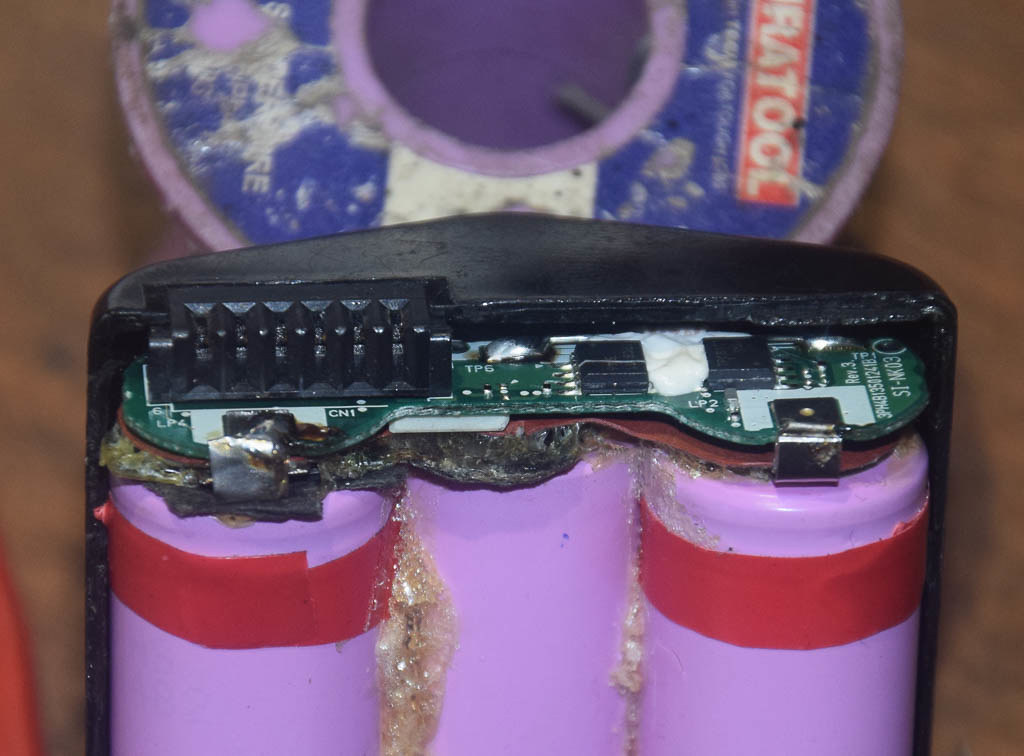 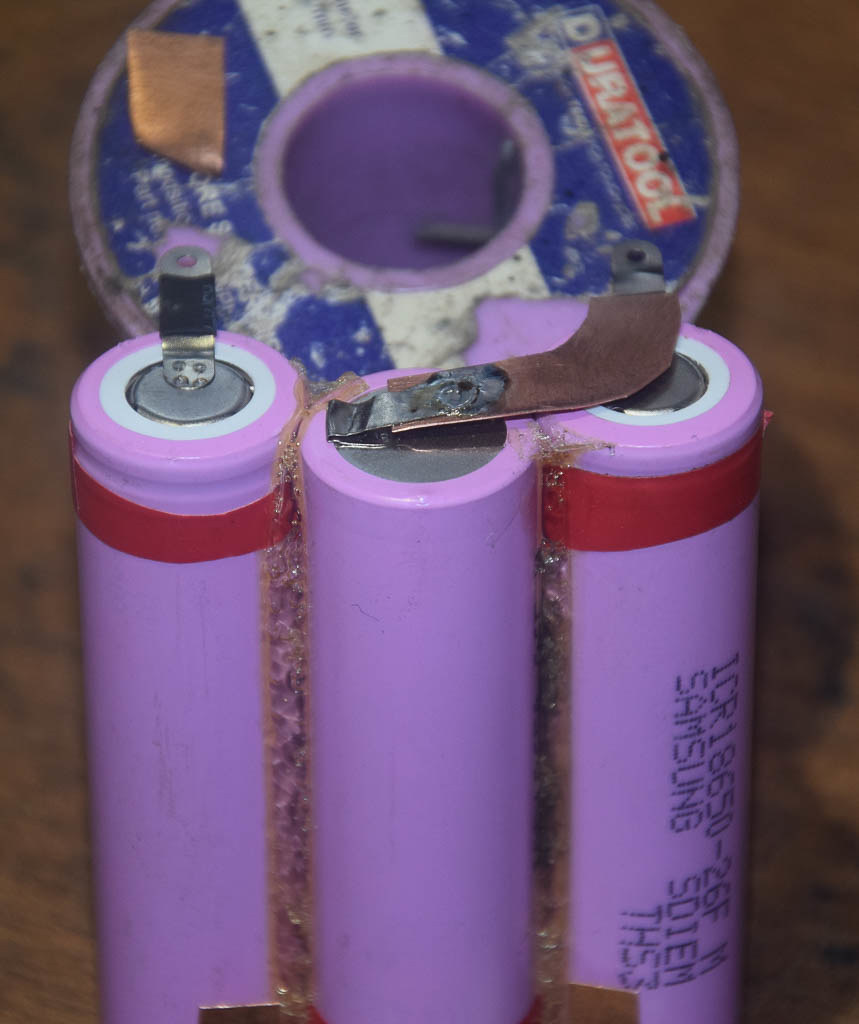 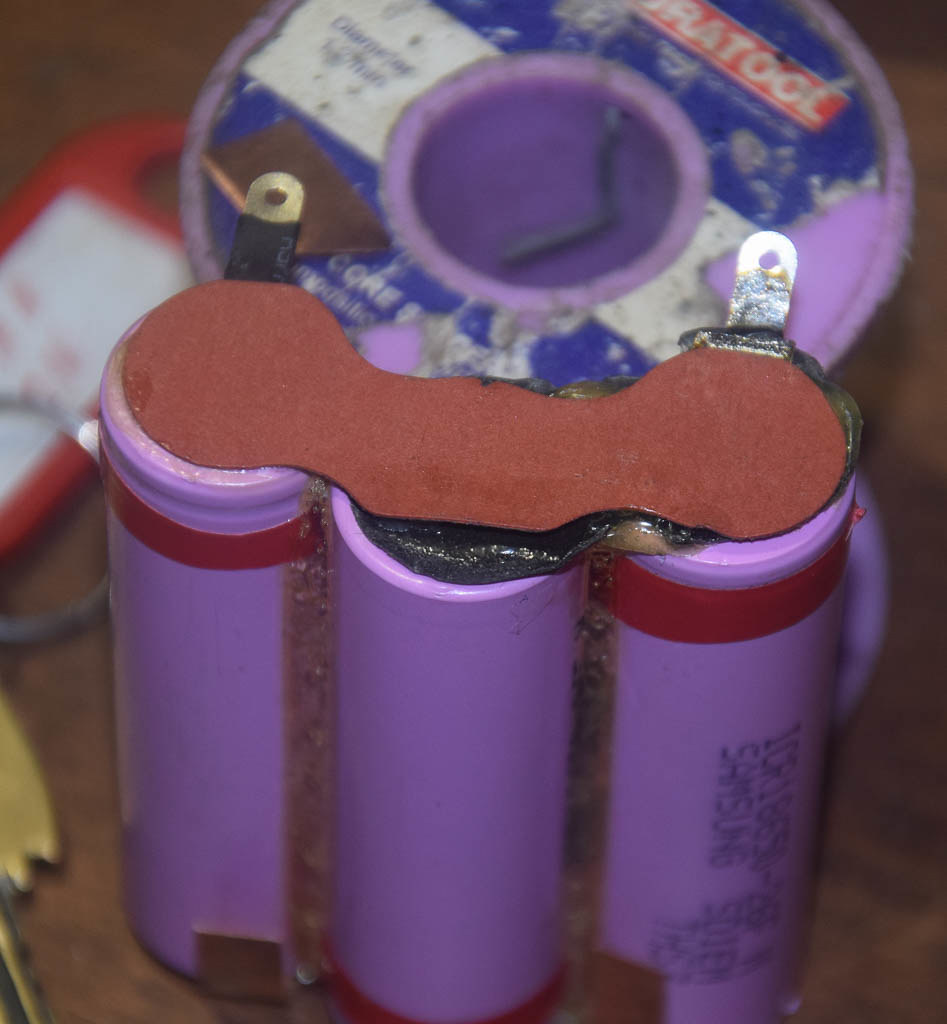 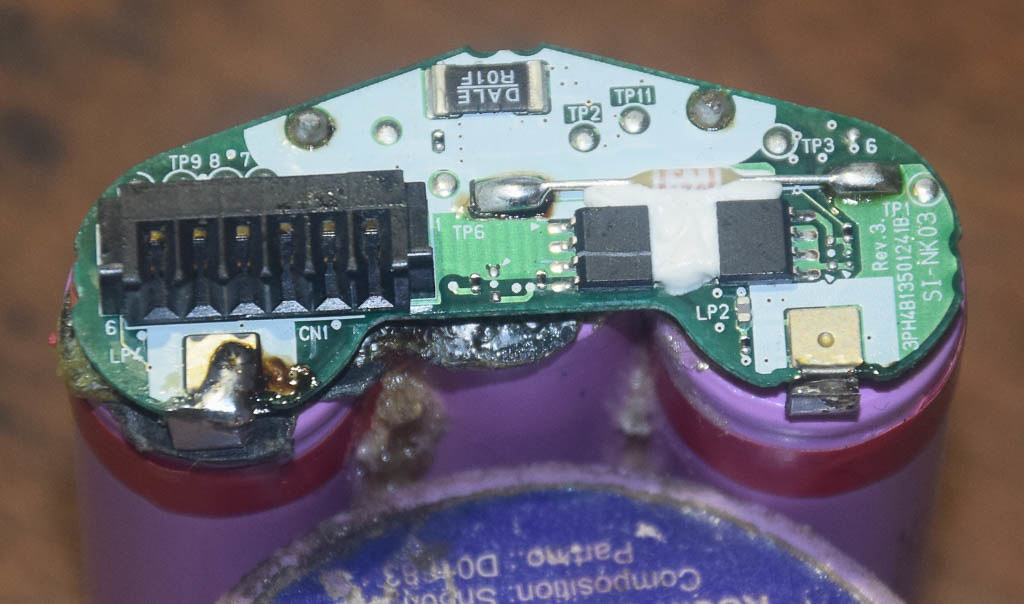 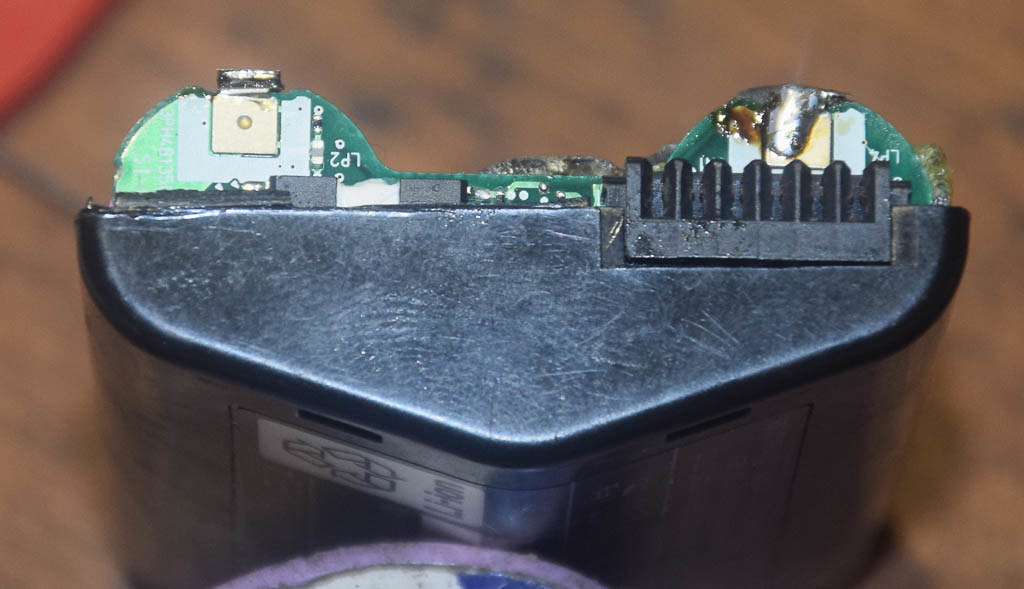 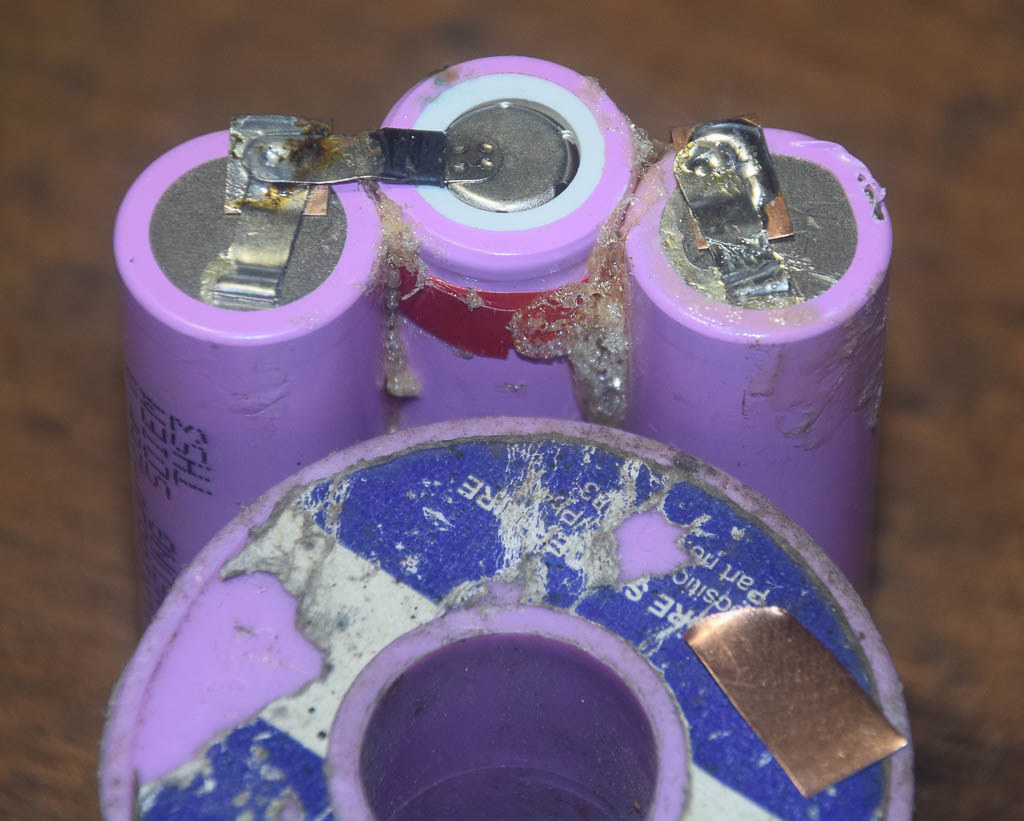 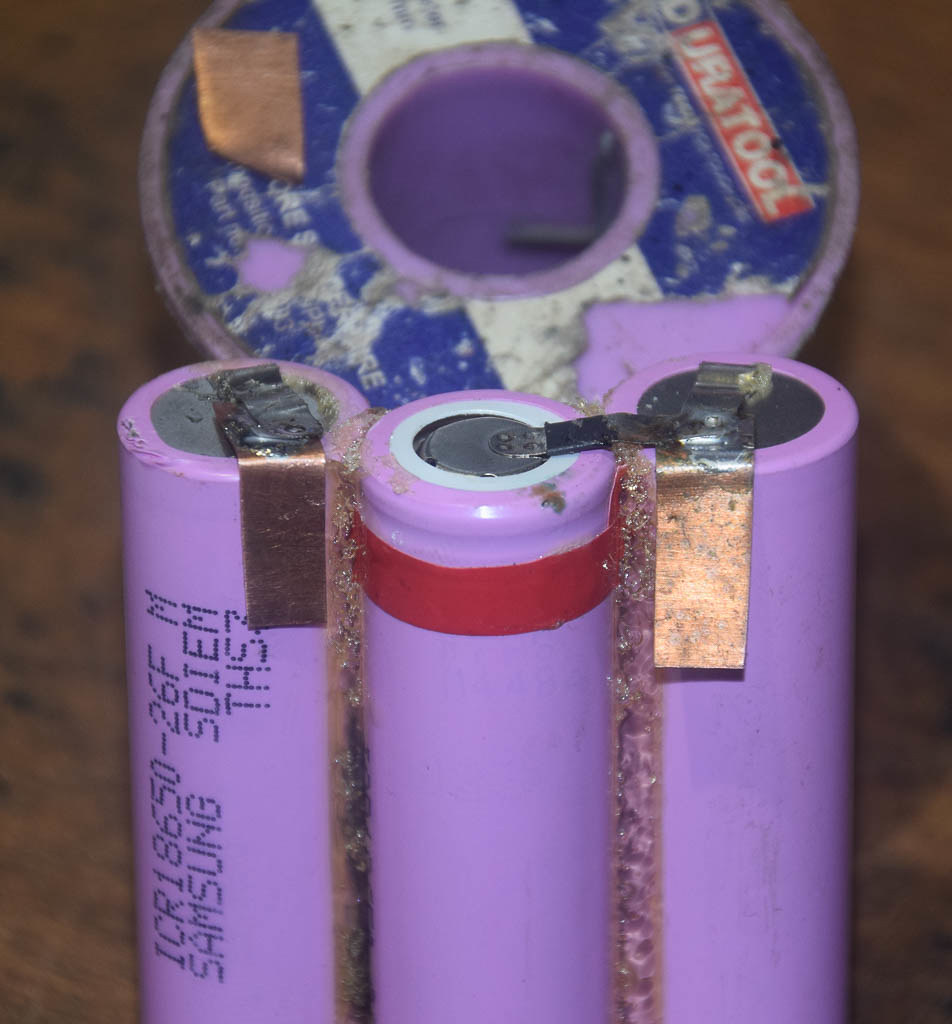  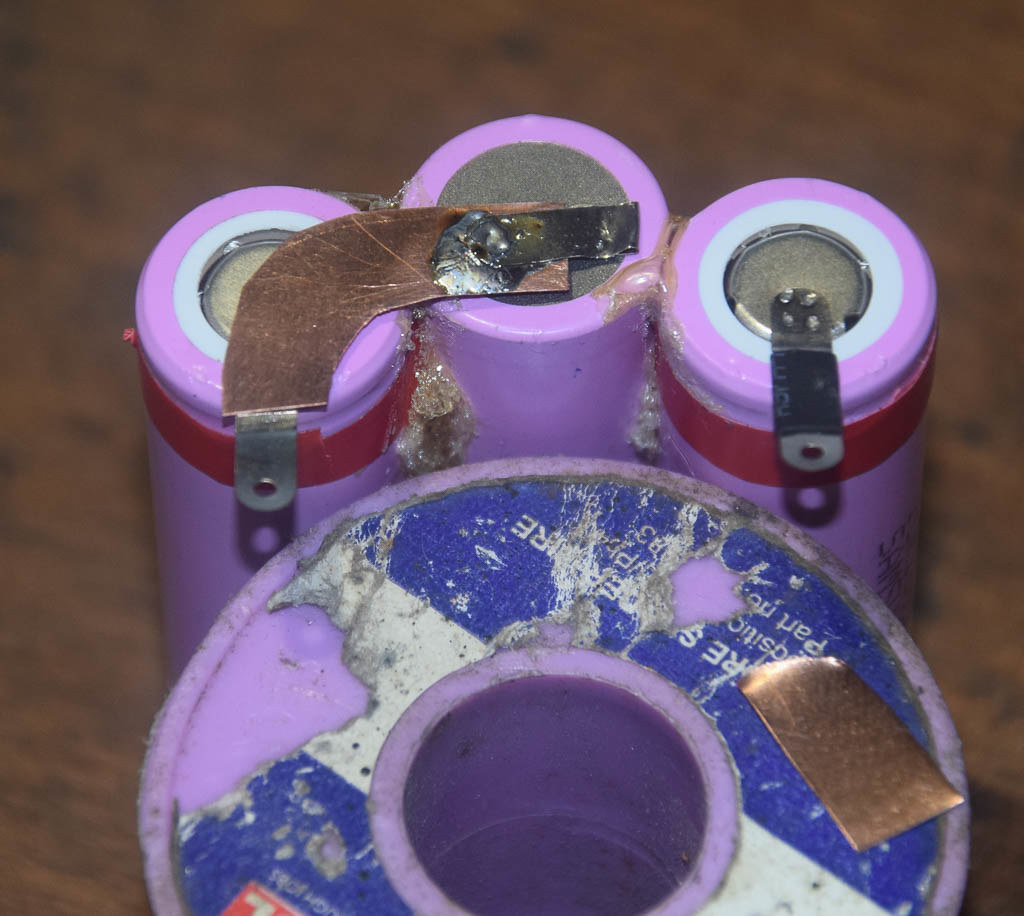 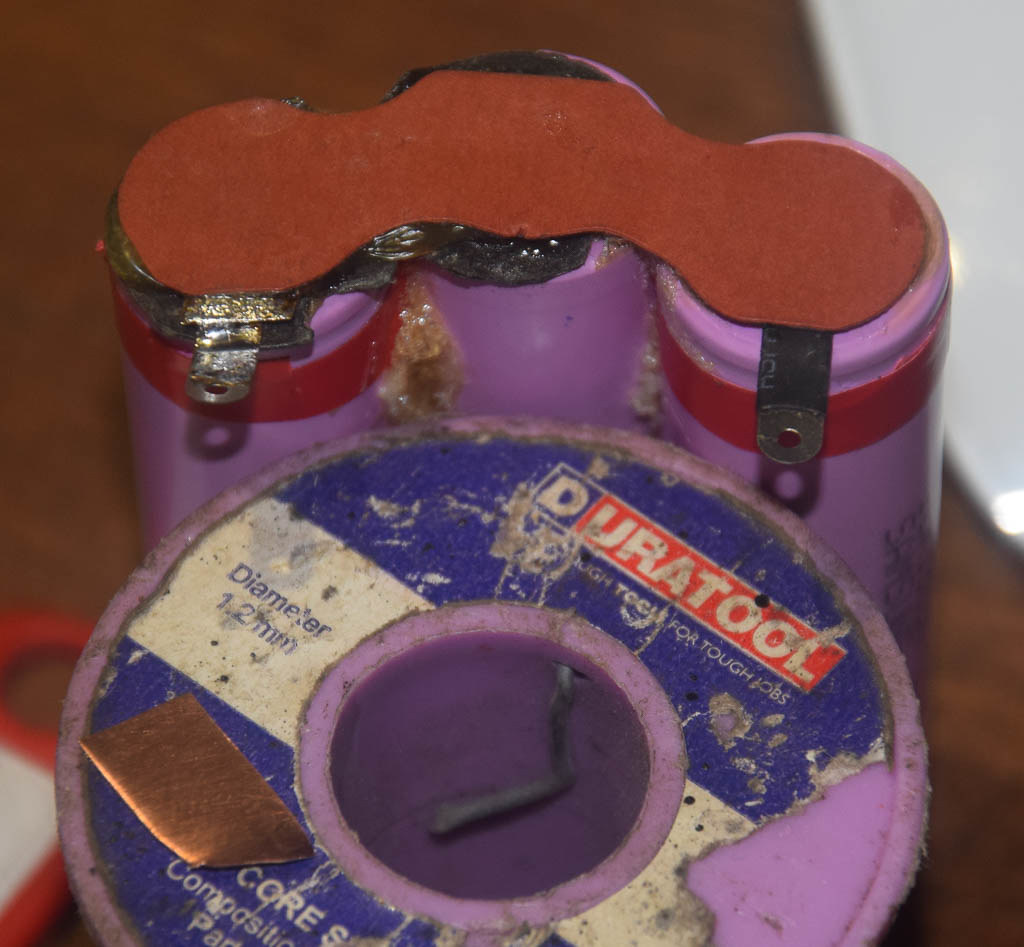 Not as neat as I would like but it's working, it has completed the re-calibration but the camera still thinks it's on life 4. The copper strips are 7 thou of an inch thick, 0.18mm, I calculated they are at least 1.2 sq. mm cross section and are greater than the new Samsung battery tags which are also 7 thou thick. I am thinking the copper should also be lower resistance than nickel plated steel. I have epoxied the casing back together so in the morning it will probably be as good as it gets. Not sure if I feel like doing a second one, I will see how this one fares first.
____________________ Robert. |
| Posted by jk: Thu Feb 15th, 2018 15:29 | 24th Post |
| Well done. First one is always the most difficult.
____________________ Still learning after all these years! https://nikondslr.uk/gallery_view.php?user=2&folderid=none |
| Posted by Robert: Thu Feb 15th, 2018 16:03 | 25th Post |
I know, the D1 battery was even more difficult. I guess that experience has helped here. I posted the photo's to give anyone else contemplating the task a better idea of what to expect. One other thing... When carefully splitting the case, the cells are stuck to the bottom half with thin, double sided sticky tape, that is with the Nikon label being the top. I progressed it one step at a time, now the case is together I will let the epoxy two pack glue set well overnight. Tomorrow will label it and trim any roughness off the seams, then go take some photos!
____________________ Robert. |
| Posted by Robert: Fri Feb 16th, 2018 01:46 | 26th Post |
| The glue has hardened overnight, removed the clamping tape I wrapped it with and it fits in the D3 perfectly. I have taken a set of photos of the case, the seams are pretty good except for the corner near the connection socket. There is slight displacement there, I think when I took the case apart I tried to keep clear of the socket with my knife and the corner may have been distorted when I pulled it apart. Other than that it's pretty well perfect. Just hope there won't be any long term issues or the chip inside decide it won't take charge any more... Am slightly annoyed the 're-calibration' hasn't actually reset the chip. I guess that's too much to hope for.  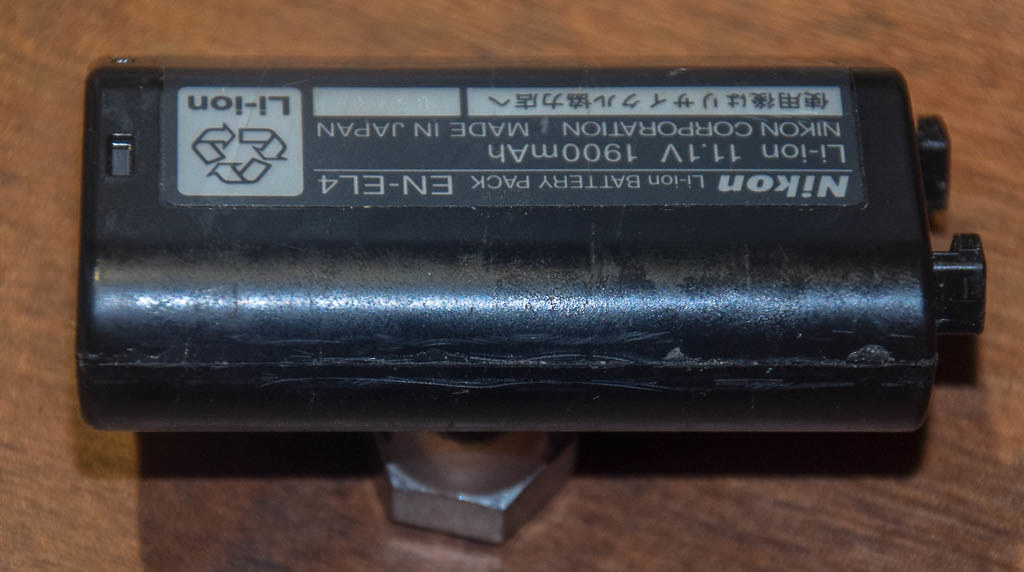 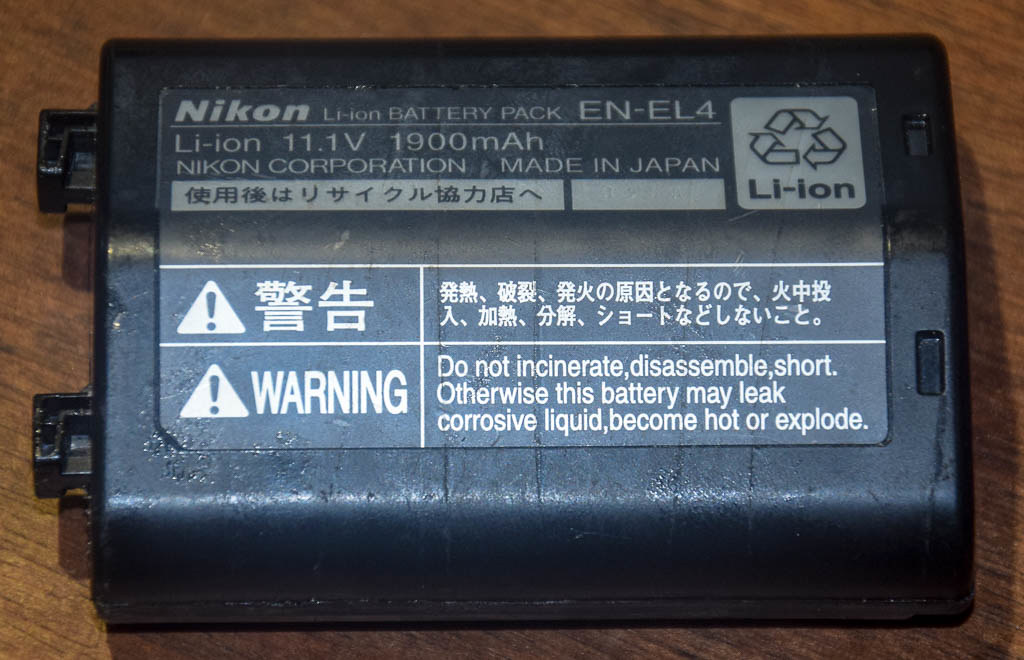 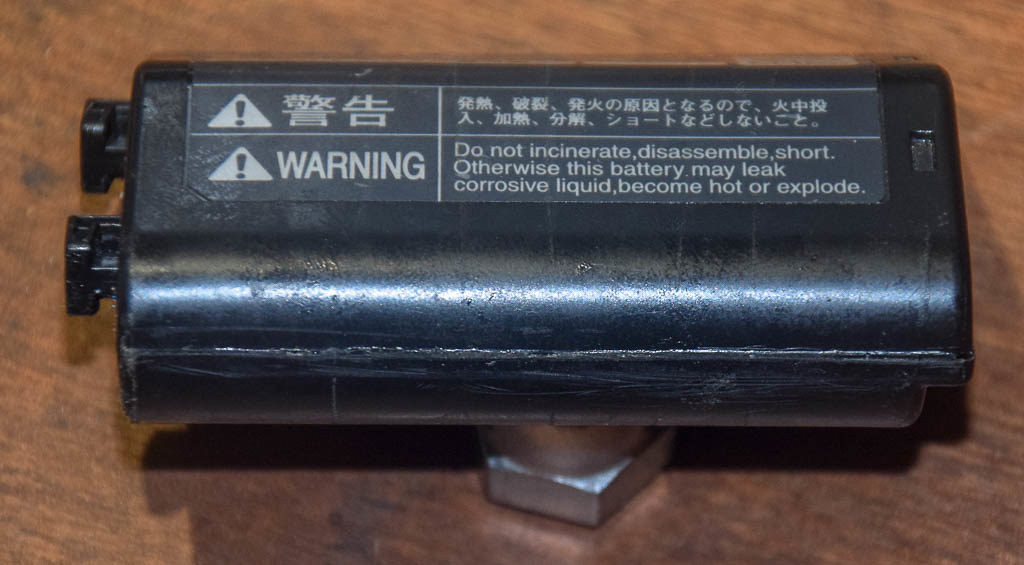 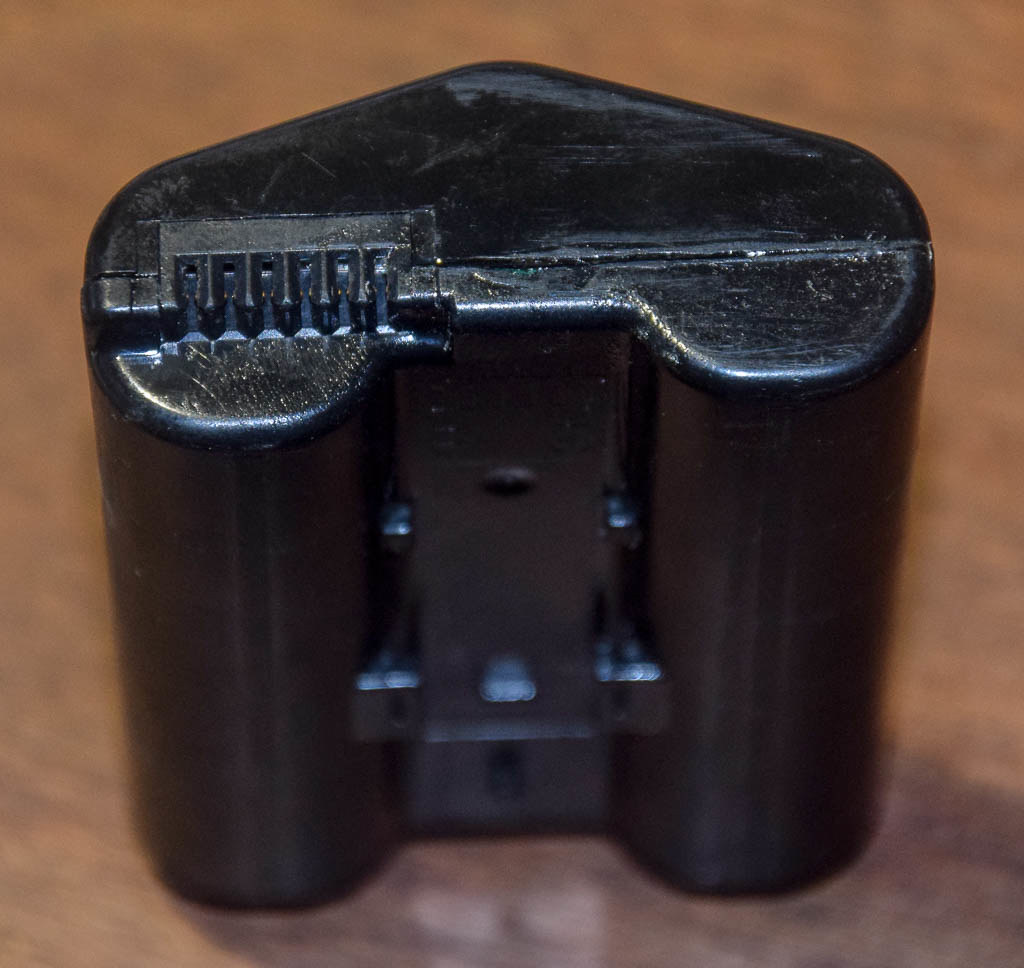 I think that's enough excitement for now! Need to get out and take some photographs.
____________________ Robert. |
| Posted by GeoffR: Fri Aug 31st, 2018 08:06 | 27th Post |
| For what it is worth, the battery life counter appears to be a hardware function and cannot be reset. Unless someone knows otherwise.
|
| This is topic ID = 1496 | ||
| Nikon DSLR Forums > Light, Lighting Techniques, Strobes and LEDs Forums > Build It Yourself > Re-celling an EN-EL4 battery | Top | |
Users viewing this topic |
||
Current theme is Blue
| A small amount of member data is captured and held in an attempt to reduce spammers and to manage users. This site also uses cookies to ensure ease of use. In order to comply with new DPR regulations you are required to agree/disagree with this process. If you do not agree then please email the Admins using info@nikondsl.uk Thank you. |
Hosted by Octarine Services
Copyright © 2008-2024 Data 1 Systems
Page processed in 0.1613 seconds (69% database + 31% PHP). 165 queries executed.
Copyright © 2008-2024 Data 1 Systems
Page processed in 0.1613 seconds (69% database + 31% PHP). 165 queries executed.